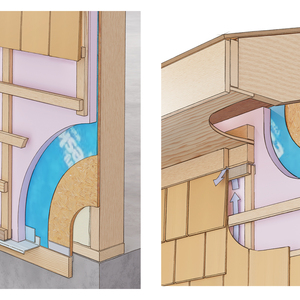bonding a steel “I” beam – not in code

Hello,
I havn’t seen any requirement to bond (ground) a steel “I” beam. In my last house, I put one over the garage unbonded. It seems to me that if you run wires past the “I” beam and is somehow the “I” beam becomes electified, you would be in serious trouble if it was not grounded (e.g. exposed “I” beam in basement ceiling).
Does anyone know if bonding a steel “I” beam is required by code or common practice?
Thanks,
Roger <><



















Replies
Whenever we have a lightning potection system put in they also go through the house and bond all the stuctural steel. Otherwise I have never seen it done.
Roger, never seen it, but sounds like a good idea. There are usually only one or two steel beams in a house, if any, so it wouldn't be much extra work. Pretty slim chance of bare wires touching a beam, but it could happen.
Mike
IMO it is not required but it would seem to be a good idea. I haven't seen a whole lot of people getting hurt or houses burning because of ungrounded I-beams so not a big issue either way. Pretty easy with a simple clamp or a lug bolted on and a length of #6 solid run to the ground bar of the panel.
With only a quick look the only NEC section that seems to apply:
"240.4 General requirements for grounding and bonding.
(A)Grounding systems.
(4)Bonding of electrically conductive materials and other equipment:
Electrically conductive materials that are likely to become energized shall be connected together and to the electrical supply source in a manner that establishes an effective ground-fault current path."
If cables were draped or fell into contact with the I-beam there would be a chance that the normal movements of the cable under changing loads and continuous pressure that the jacket and insulation could fail and allow live conductors to contact the I-beam. If the beam were not grounded it likely would remain energized and potentially dangerous.
If grounded any live wire contacting it would short to the beam causing a large surge that would cause the breaker to trip. Deenergizing the circuit and eliminating the hazard. Also, because the circuit could not be reset, stimulating research to find the fault and repair it.
I have seen, and corrected, similar faults where cables have been draped, either due to a lack of workmanship or failure of attachments, across ducts or pipes in attics or crawl spaces. IMO, based upon getting shocked by ungrounded ducts or pipes, it is far better to have the circuit breaker trip but this must be weighed against the odds that the I-beam might become energized.
If there is electrical equipment in proximity to the beam, within 6' being a good rule of thumb, or if cables or conduits are run close to it I would lean more to grounding it. If there is not electrical equipment or cables and such close to it, and the distance to the grounding point is considerable, raising the cost and trouble, I would tend to let it slide. In that case there are likely other issues that will give you a better quality job at less cost and trouble.
On commercial and industrial jobs we always run a bonding jumper to a column or bar joist nearest the electrical service.This is covered in NEC 250.104 "Bonding of Piping Systems and Exposed Structural Steel".The jumper has to be sized to the chart in 250.66.I don't know if your inspector would consider an I beam in a wood construction building to be "structural steel",but, I don't know why not.
The one thing you don't want to do is install a connection that is likely to corrode and turn into a high resistance path. No ground at all is probably better than something you think is a good ground path but isn't.
Good point.